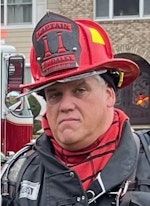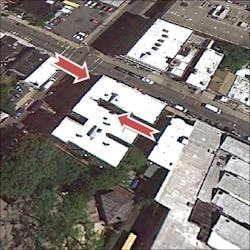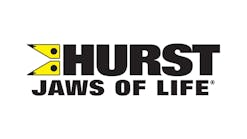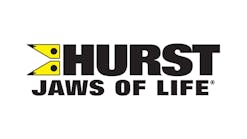Many a seasoned incident commander will be sure to tell you that, out of the myriad of tasks that must be performed at a structure fire, there are at least a half dozen or so that must be accomplished within the first five minutes of the fire. One of these tasks is ventilation of some sort, depending on the situation found upon arrival. The benefits of proper, coordinated ventilation are plentiful, including removing heat and smoke, making the engine company's push into the building a bit easier, and even creating an avenue for the rescue of trapped occupants. While most of these ventilation tasks are in support of an offensive attack, the trench cut is certainly not one of them.
The trench cut (otherwise known as "strip ventilation") is a long narrow ventilation hole that acts as a fire break on the roof of a structure that is being attacked by fire. This tactic is used when confronted with a stubborn concealed fire that is difficult to reach, or a fire that has a stronghold on the attic or cockloft space of a long, narrow building. It can also be used for a top floor fire within a building with a choke point, or "throat" in the roofline where a trench can be cut (see Photo 1). The main focus of this defensive tactic is to cut off fire extension to an area of the building that has not been involved in fire; this means that a portion of the building will be "written off," so to speak.
Keep in mind that many buildings will not possess the necessary attributes to employ a trench cut. For example, H-shaped buildings would benefit from the use of the trench cut during operations, as the building will have a choke-off point in the center of the structure, which can act as a pinch point for smoke and heat (see Photo 2).
Older, narrow Type III (ordinary) constructed taxpayers would benefit from this tactic, as the construction method used in the roof area may provide crews with an increased operational time frame to complete the trench. Adversely, newer lightweight strip malls would not be a positive candidate for this tactic. The main reason is the safety concerns when dealing with lightweight construction. Many of these newer strip malls are Type II construction, containing steel bar joists with light decking for roof sheathing. On top of the sheathing would be membrane-style roofing materials, hot tar layers and insulation materials as well. Cutting through this material would tend to decrease the efficiency of the saws, requiring a considerable amount of time to complete roof operations. As a rule, this type of construction does not lend itself to extended roof operations (see Photo 3).
Furthermore, buildings with a considerable amount of square footage on the roof would not be candidates for this technique. Consider a strip mall that measured 50 feet deep and 200 feet long, with four stores within the building. Cutting a trench in this roof would require two long cuts of 50 feet each to make the trench. Relief cuts in the trench itself would have to be cut at a maximum of every 5 feet, to keep the roof trench sections manageable for crews. This would add over 30 more feet of cuts to be made, which puts the total area to be cut over 130 feet! That is a significant amount of roof material that would need to be cut, requiring additional companies that may only be available through additional alarms to perform the cutting, and be available to open the trench when coordinated with fire attack. Perhaps these resources can be utilized while employing a different technique to halt the fire spread, such as pulling large areas of ceilings from within the fire building after the roof has been vented, and placing larger handlines into operation to stop the spreading flames.
Trenching The Roof
When assigned the task of performing the trench cut, be sure to size-up the roof you will be operating on. Consider the following:
- Where is the fire? The first step of performing the trench cut requires the crews to place a large vent hole (10 feet by 10 feet) over the fire, to allow heat and smoke to exit the structure, and to buy the roof team time to complete the trench. Unfortunately, this step is quite frequently overlooked, and the fire tends to roar right past the prospective trench area.
- What is exiting the roof? Is there already fire or heavy smoke coming through the roof in an area that has failed? If this is the case, the prudent fire officer may re-think the decision to trench the roof (see Photo 4).
- What materials make up the Roof? Knowing the materials will allow your crews to bring the right blades for the saws and other necessary tools to open the trench.
- Is the roof spongy/sagging/blistering in areas? Be sure to identify any areas that are weakened and failing; operations may have to be adjusted due to roof conditions.
Starting The Operation
Gaining access to the roof for this operation should begin from a well supported area of the roof, preferably from the opposite side of a fire wall or other substantial separation. At least two means of egresses shall be in place and secured for rapid egress from the roof area should the operation turn for the worse. A minimum of two fully staffed companies are a good start for this type of operation and the incident commander (IC) will need to consider relief for them during the operation. Approach the roof from a safe area, and start off by making a large vent opening directly over the fire to allow smoke and heat to exit the structure. This will also buy some time for the companies to complete the trench cut.
Once that opening has been completed, look for a suitable spot to cut the trench, at least 20 feet from the original ventilation opening. Look for some existing roof openings that can assist in making the trench cut (vent chases, scuttle hatches, bulkhead doors, etc…) and cut from these openings; the existing openings will lessen the amount of area the crews will have to open up. Look for a pinch point or "throat" area of the building that will facilitate cutting the trench. Optimally, limiting the length of the cut from side to side will decrease the time needed to make the cut and it will get the crews off the roof faster.
Prior to cutting the trench, the crews should make a few inspection holes between the existing vent opening and the area for the trench to be cut. An inspection hole is a series of three Kerf Cuts (a cut in the roof material the same width of the rotary blade in use) in the shape of a triangle. These inspection holes will serve as early warning as the fire progresses in the direction of the trench. A few inspection holes should also be cut beyond the trench area as well; if the fire has jumped the trench area, it may be necessary to move the trench cut further down the roof (see Photo 5).
Making The Cut
Once a spot is chosen for the trench, check the direction of the roof rafters. Cutting the trench in the same direction as the roof rafters are running can save the roof crew valuable time. For example, if the trench is cut with only one rafter within the trench sides, the trench panels can be pivoted open on only one nailed rafter. If the roof rafters are wide enough apart, the trench may be able to be cut completely within the rafters, and the sections can be lifted out entirely. If the trench is made perpendicular to the direction of the rafters, many more relief cuts will be required to open up the trench panels.
Starting from the upwind side, with the crews located between the trench and the means of egress, make two straight cuts approximately three feet wide, from one wall completely to the opposite wall of the building. Remember: do not cut the trench between you and your egress! It will be necessary to put perpendicular relief cuts throughout the length of the trench cut. Make the relief cuts at approximately every five feet down the length of the trench cut; this will keep the sections of the trench cut manageable for crews to manipulate open.
Opening The Trench
The trench cut is just one part of the overall strategy on the fireground; a major portion of the operation involves a second part, the actual opening of the trench. Therefore, it is imperative that strict coordination between the suppression teams and the roof teams be adhered to. Command should have large hose streams placed underneath the area of the trench cut, to suppress any fire that may come towards the opening. When ready, the roof team shall open up the trench, and punch out the ceiling below the cut area. Once opened, do not stand by and admire your work; get off the roof immediately. The introduction of products of combustion with the fresh air above the roof may result in vent-point ignition, so it is critical that a protective hoseline be in place to assure the safety of the roof teams as they exit the roof.
Conclusion
The trench cut is a valuable tool that is in the IC's "tool cache". Much consideration should be made before deciding to incorporate this tactic. The defensive posture of saving a portion of the building will result in writing off a section of the structure. The manpower and equipment needs of this tactic will require the progressive IC to call for multiple alarm companies early in the incident so they are on-hand to be deployed early in the fire. Delaying the start of this tactic will increase the loss of the property, to a potential level that the entire structure may be a total loss. Thanks to today's technology, it is not necessary to go out for hours on end and do roof surveys; programs like Google Earth and Bing Maps can allow you to view your first due response area for potential trench cut operations, and preplan alarm assignments before the fire.
Until next time, stay focused and stay safe.
MICHAEL P. DALEY is a lieutenant and training officer with the Monroe Township, NJ, Fire District No. 3, and is an instructor with the Middlesex County Fire Academy, where he is responsible for rescue training curriculum development. Mike has an extensive background in fire service operations and holds degrees in business management and public safety administration. Mike serves as a rescue officer with the New Jersey Urban Search and Rescue Task Force 1 and is a managing member for Fire Service Performance Concepts, a consultant group that provides assistance and support to fire departments with their training programs and course development. Mike has been guest on several Firehouse.com podcasts including:Successful Rescue Operations in Today's Fire Service, Preparing for Tomorrow's RIT Deployment Today and Basement Fire Tactics Roundtable podcasts. View all of Michael's articles and podcasts here. You can reach Michael by e-mail at: [email protected].

Michael Daley
MICHAEL DALEY, who is a Firehouse contributing editor, is a 37-year veteran who serves as a captain and department training officer in Monroe Township, NJ. He is a staff instructor at multiple New Jersey fire academies and is an adjunct professor in the Fire Science Program at Middlesex County College. Daley is a nationally known instructor who has presented at multiple conferences, including Firehouse Expo and Firehouse World. His education includes accreditations as a Chief Training Officer and a Fire Investigator, and he completed the Craftsman Level of education with Project Kill the Flashover. Daley is a member of the Institution of Fire Engineers and a FEMA Instructor and Rescue Officer with NJ Urban Search and Rescue Task Force 1. He operates Fire Service Performance Concepts, which is a training and research firm that delivers and develops training courses in many fire service competencies.







